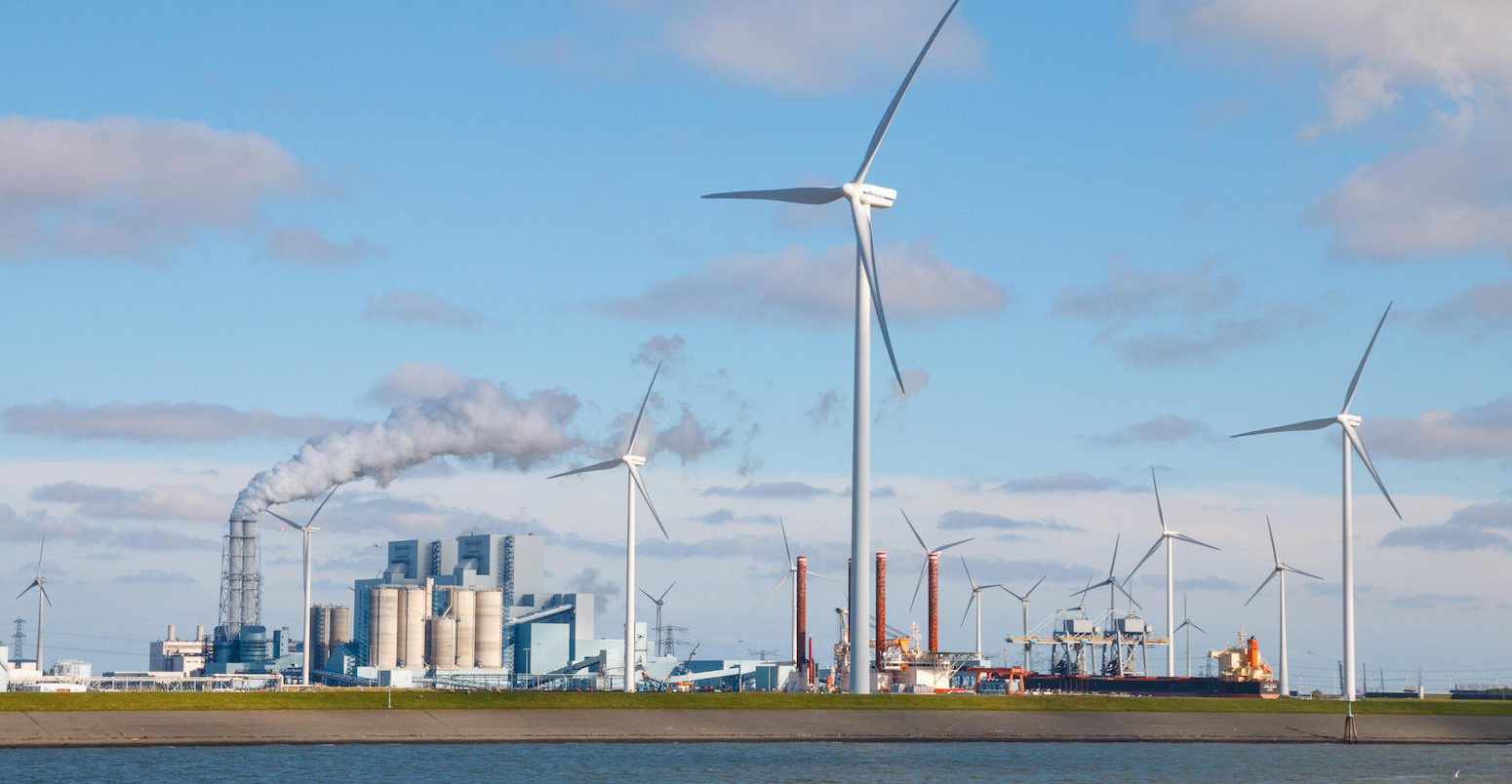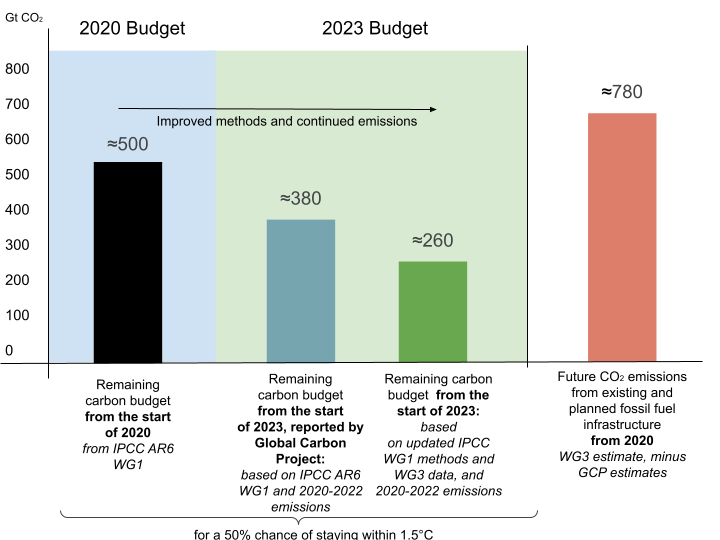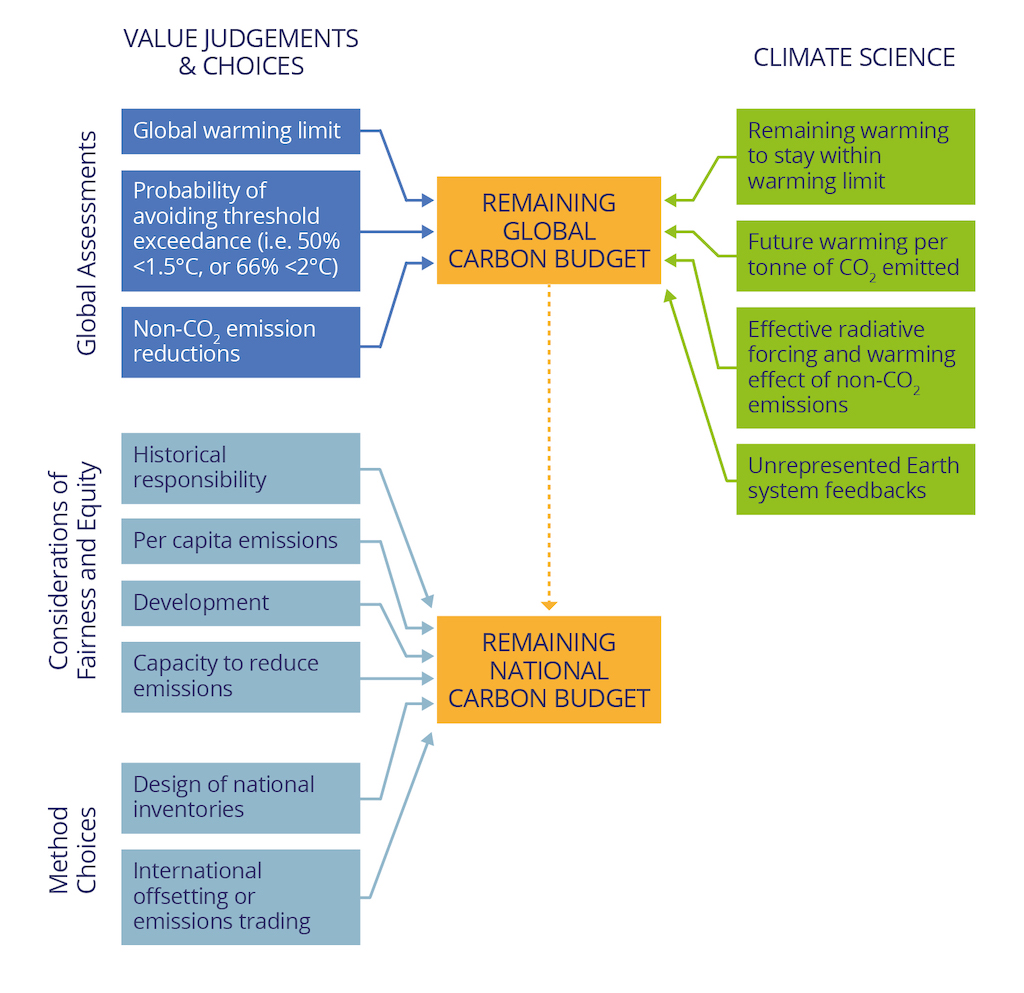
Guest post: What the tiny remaining 1.5C carbon budget means for climate policy
Multiple Authors
11.11.22Multiple Authors
11.11.2022 | 12:28pmThe latest estimates from the Global Carbon Project (GCP) show that total worldwide CO2 emissions in 2022 have reached near-record levels.
The GCP’s estimates put the remaining carbon budget for 1.5C – specifically, the amount of CO2 that can still be emitted for a 50% chance of staying below 1.5C of warming – at 380bn tonnes of CO2 (GtCO2). At the current rate of emissions, this budget would be blown in just nine years.
While that is a disconcertingly short amount of time, the budget for 1.5C may actually be even tighter.
Combining the latest insights from the Intergovernmental Panel on Climate Change (IPCC) with the GCP’s data, we estimate that the remaining 1.5C carbon budget could be just 260GtCO2 – around 120GtCO2 smaller. If emissions continued at current levels, this budget would run out in around six and half years.
However, reducing the remaining carbon budget to a single number means that many of the factors and uncertainties involved in calculating it – and their implications for decision-making – are missed.
With the immense efforts of the GCP, we know that there is still no sign of the sustained fall in global CO2 emissions needed to meet the Paris Agreement warming limits.
Cutting global CO2 emissions to zero by 2050, in line with limiting warming to 1.5C, would require them to fall by about 1.4GtCO2 every year, comparable to the drop in 2020 as a result of Covid-19 lockdowns around the world, but this time driven by a long-term, structural change of the economy.
This highlights that the scale of the challenge is immense, no matter the precise figure of the rapidly shrinking carbon budget.
Carbon budgets and scientific complexities
The IPCC sixth assessment (AR6) Working Group I (WG1) report estimated that, at the start of 2020, the remaining global carbon budget for a 50% chance of staying within 1.5C warming was around 500GtCO2.
Based on IPCC and GCP figures, we estimate that future cumulative CO2 emissions from existing and planned fossil-fuel infrastructure around the world would add around 780GtCO2 in emissions from 2020.
This highlights the scale of the global challenge of transitioning to net-zero.
During 2020 and 2021, global CO2 emissions amounting to around 70-80GtCO2 have eaten into that 500GtCO2 budget.
The GCP shows that emissions were even higher in 2022, increasing to more than 40GtCO2 – just short of 2019’s record levels.
Using the IPCC WG1 approach to calculate carbon budgets, this would give a remaining carbon budget of 380GtCO2 from the start of 2023, equivalent to nine years of current emissions. This is the budget quoted by the GCP.
This, however, might even be an overestimate. Assessing the remaining carbon budget is complex and because a large share of the total budget has already been emitted, relatively minor improvements in scientific knowledge can have large consequences for these estimates.
Since the WG1 report was published in August 2021, some of the evidence available and methodology used to calculate the budget has been updated. This is explained in the latest “ZERO IN” report from the CONSTRAIN research project.
Broadly, this includes overall improvements to the climate models used and the incorporation of new knowledge on how non-CO2 emissions will contribute to future warming. The primary change was in the role of aerosols from air pollution, which currently act to offset some of the warming effect of CO2. As we phase out carbon emissions, these aerosols will also decline, causing a relative warming effect. Recent data has increased the best estimate of this effect and so this results in a smaller remaining carbon budget.
Taken together, these updates mean that the remaining carbon budget could be around 120GtCO2 smaller than expected. (For more details, see Box 3.4 in chapter 3 of the IPCC Working Group 3 (WG3) assessment.)
This is illustrated in the chart below, which shows the original IPCC WG1 estimate for the 1.5C budget from the start of 2020 (black bar), the GCP estimate from the start of 2023 (teal) and our update (green). For comparison, the red bar shows the potential CO2 emissions from existing and planned fossil-fuel infrastructure from 2020.
This would reduce the remaining carbon budget from the start of 2023 to around 260GtCO2.

The remaining carbon budget and policy choices
While the “number of years left” for a carbon budget can generate headlines, relying on a single number to determine the future of humanity has its problems.
The remaining carbon budget is a valuable concept for continually focusing global efforts on the urgent need to cut emissions. It also clearly lays out the most fundamental requirement for what climate policy needs to deliver in order to stop global warming, namely, bringing global CO2 emissions down to net-zero.
However, relying on a single number can also play into “discourses of climate delay”. It is easy to misunderstand as the number of years before the world needs to act, while the short time might even lead some to suggest that the remaining carbon budget is so small that it is pointless to even try.
Furthermore, the ever-decreasing size of the carbon budget means there are quite large uncertainties around a very small number.
For example, minor variations in how the climate will respond as emissions build up in the atmosphere can have a relatively large impact on a budget that is already tiny compared to the CO2 emitted from fossil-fuel use and deforestation since the Industrial Revolution (around 2.5tn tonnes).
In addition, as the figure below illustrates, there are a number of climate-science choices involved for estimating the carbon budget, such as how much warming each tonne of CO2 causes or the way feedbacks in the Earth system are accounted for.

Most importantly, the remaining carbon budget is only for CO2, with non-CO2 greenhouse gases and the role of other pollutants included indirectly based on how they are projected to evolve in low-carbon scenarios created with Integrated Assessment Models.
In this way, carbon budget estimates already take into account the reduced cooling effect of a drop in air pollution that comes with cutting fossil fuel use.
They also already assume stringent reductions in other greenhouse gases – therefore, efforts to address them such as the Global Methane Pledge do not increase the remaining carbon budget estimates of the IPCC. On the contrary, the remaining carbon budget would be smaller if countries fail to deliver on the methane pledge.
Small changes in the scenarios and estimates we use therefore have an impact on the single number produced for the remaining budget.
For example, one of the changes between the GCP estimate and our own is that we have used non-CO2 scenarios taken from the more-recent IPCC WG3 assessment. These warm slightly more than those used in the WG1 report, further decreasing the budget slightly.
All these factors mean that the diminishing carbon budget has become increasingly impractical as a tool for setting climate policies.
Fundamentally, whether the 1.5C budget would be exhausted in nine or six-and-a-half years, the need for rapid climate action is just as urgent.
Counting carbon
The carbon budget provides a simple approximation of how fast the world must decarbonise. However, watching the clock count down is becoming an increasingly uninformative way of communicating the urgency of climate action.
It is important to note that it is neither harmless to keep emitting CO2 up until the budget is blown, nor instant armageddon if it is exceeded.
Instead, the carbon budget forms part of the political debate on how the world can best ensure that neither climate change, nor the actions taken to avoid it, will harm the most vulnerable.
Cutting emissions hard and fast now will give whatever budget is left a longer lifetime, as well as giving time and space to implement existing and new ways to limit emissions that are fair for all.
Developing carbon removal techniques at scale is also important. It is necessary to pay back the carbon “debt” if – or when – the world exhausts the budget before reaching net-zero.
Carbon removals also provide insurance against the risk of overestimating the size of the remaining budget. There are numerous ways that long-held carbon could be affected by climate and human activity in future – from deforestation and thawing permafrost to peatland loss and carbon-cycle feedbacks. These influences could make the tiny remaining carbon budget even smaller.
-
Guest post: What the tiny remaining carbon budget for 1.5C means for climate policy





